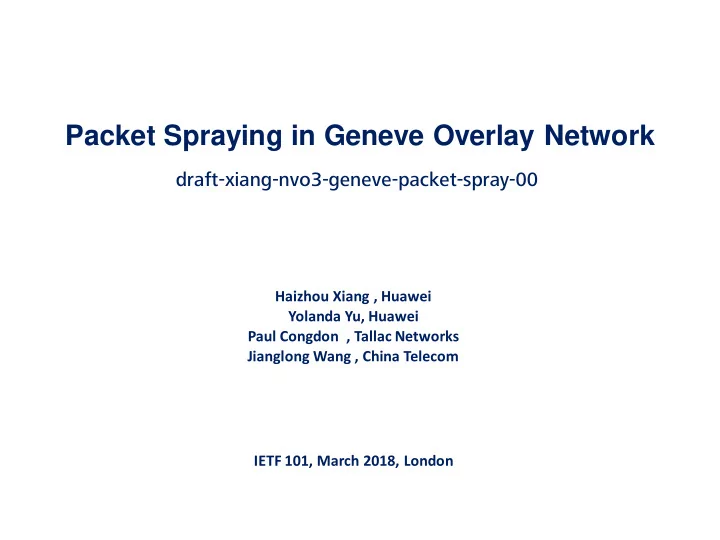

Packet Spraying in Geneve Overlay Network draft-xiang-nvo3-geneve-packet-spray-00 Haizhou Xiang , Huawei Yolanda Yu, Huawei Paul Congdon , Tallac Networks Jianglong Wang , China Telecom IETF 101, March 2018, London
In In-netwo work rk Congesti tion In-network congestion : occurs within the interconnection network channels, due to poor traffic spraying. Path selection can be treated as load balancing issue Load balancing technologies are used to solve in-network congestion: such as ECMP, Flowlet, Packet Spraying Packet is both finer granularity and suitable for open system. Packets belong to the same flow may go through different paths, which may lead to packets out of order.
Coping with th In-network twork Congesti tion Packet Spraying (PS) = Packet Spraying + Reordering Distributed Finer Granularity In In-Ordering Spine Spine Spine Spine 3 5 4 3 4 5 6 6 Spray packets 1 over paths Leaf Leaf Leaf Leaf Leaf Leaf 7 2 7 2 … … … … … … 8 1 8 1 2 Reordering @ Dst-end Packet spraying at Src-end (Leaf Switch or Server) o No need to modify Spine switch - Packet re-ordering at Dst-end (Leaf Switch or o Use Geneve to encapsulate the packet Sn Server) - For those (protocol or OS), who can't - tolerate packet reordering
Proposed Packet Spraying Format over Geneve Option Class = Geneve Forwarding Policy(suggested), to be assigned by IANA (TBA). Type = TBA. Length = 2 (8 byte) Flow Group ID: identifies a group of flows within the same reorder sequence space between a Src/Dst pair. A Flow Group is uniquely identified by the 3 tuple that includes Src address, Dst address and Flow Group ID. Sequence Number: value ranges from 0 to (2**32)-1
Packet Spraying function @ Src The Flow Group ID may correspond to an individual flow, some subset of flows, or even all flows between the Src/Dst pair. How the flow corresponds to the Flow Group ID is not defined by this draft. The source node allocates the sequence number according to the order packets are sent for flows of the same Flow Group.
Reordering function @ Dst The destination perform reordering to the packet with same 3 tuple( Src addr, Dst addr, Flow Group ID) by sequence number. The destination needs to notify the capability (reorder queues assigned to the peer) to the source. The source needs to tune the allocation mechanism of Flow Group ID according to the capability of destination When the number of Flow Group IDs of received packets exceed the local capability: Discard the Geneve packet for the Flow Group ID that exceeds the local capability Remove the Geneve encapsulation, without performing reordering and pass the packet to higher layer protocol. 2 2 2 1 1 1 Flow Group (Src addr, Flow Group ID, Dst addr)
Simulation Set-up • Platform: OMNET++ • 3 Tier CLOS: 10G interface, 16 Core SW, 32 Edge SW, 32 Leaf SW, 128 Server • Traffic Pattern: UDP, Uniform random destination
Performance Comparison Load balancing granularity Packet Spray Random select next hop for every packet Sub-flow Random select next hop for every 2 n packets n = ( 0 ~ 12 ) When n = 0, equal to packet spray. When n=12, close to ECMP. ECMP Select next hop by 5-tuple hash Performance factor Overall throughput Overall drops Average latency
Performance comparison 1400 30000000 Packet drops 1200 25000000 1000 20000000 Throughput0 800 Drops0 Throughput1 15000000 Drops1 600 Throughput2 Drops2 10000000 400 Throughput3 Drops3 Overall throughput 5000000 200 0 0 0 1 2 4 8 16 32 64 128 256 512 1024 2048 4096 0 1 2 4 8 16 32 64 128 256 512 1024 2048 4096 4 rounds with different random seed 1.20E-04 Packet spray achieve best performance 1.00E-04 Sub-flow Random select next hop for 8.00E-05 Latency0 every 2 n packets, with n increasing, close 6.00E-05 Latency1 to ECMP Latency2 4.00E-05 Latency3 In general, ECMP achieve worst 2.00E-05 Average Latency performance, its overall throughput is the 0.00E+00 0 1 2 4 8 16 32 64 4096 128 256 512 1024 2048 lowest.
Next Step Seek comments and more collaboration Continue the simulation on the packet reordering Validate the overall performance under a real test bed
Recommend
More recommend